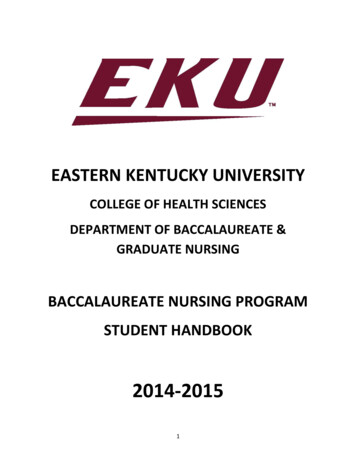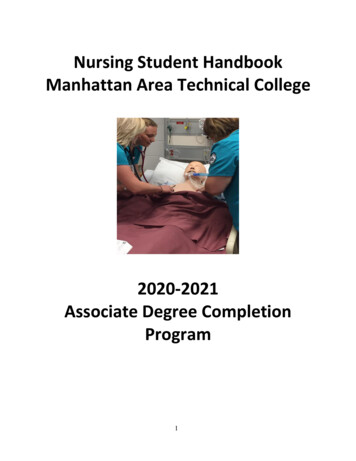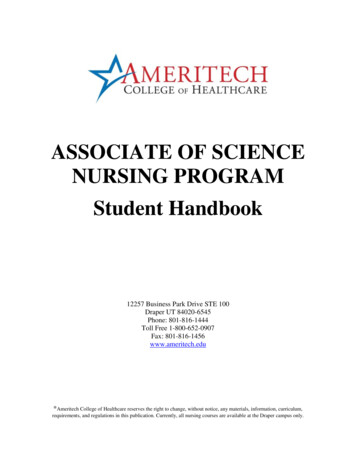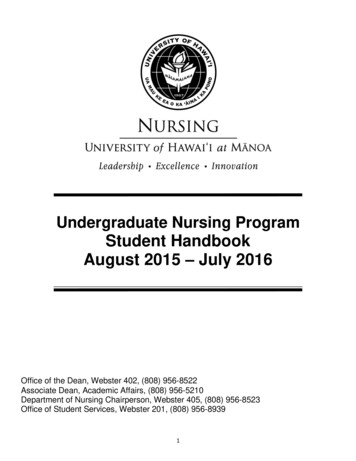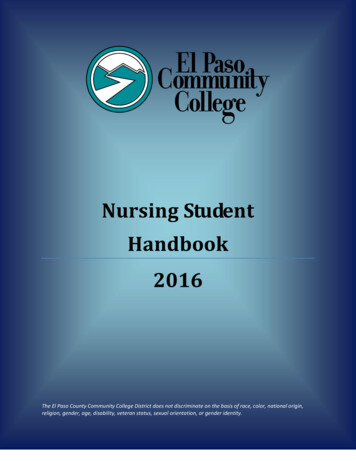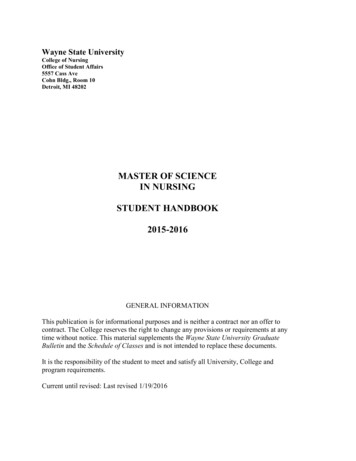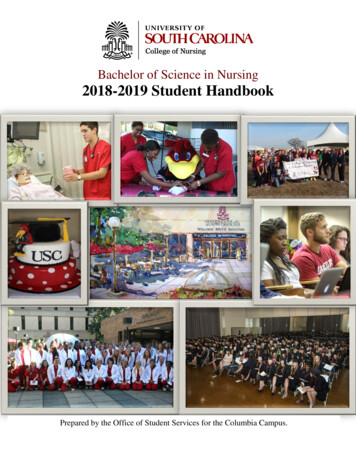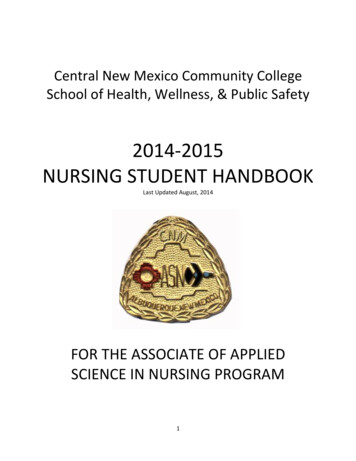
Transcription
Central New Mexico Community CollegeSchool of Health, Wellness, & Public Safety2014-2015NURSING STUDENT HANDBOOKLast Updated August, 2014FOR THE ASSOCIATE OF APPLIEDSCIENCE IN NURSING PROGRAM1
HANDBOOK AND ELECTRONIC SIGNATURES . 4STUDENT RESPONSIBILITY REGARDING THE CNM HANDBOOK .4CNM SCHOOL OF HEALTH, WELLNESS AND PUBLIC SAFETY CONFIDENTIALITY AGREEMENT .4CLINICAL CONTRACT STATEMENTS CONCERNING STUDENTS .5ABOUT THE PROGRAM . 6NEW MEXICO NURSE PRACTICE ACT: CLINICAL PRACTICE OF NURSING STUDENTS .6ACCREDITATION .6AASN NURSING PROGRAM .7PHILOSOPHY.7ORGANIZATIONAL FRAMEWORK .9ORGANIZATIONAL FRAMEWORK DIAGRAM .10NURSING STUDENT CODE OF CONDUCT .10AMERICAN NURSES ASSOCIATION CODE OF ETHICS FOR NURSES .11NATIONAL STUDENT NURSES’ ASSOCIATION (SNA) .11SNA CODE OF PROFESSIONAL CONDUCT .12PROGRAM EXPECTATIONS .12EXIT COMPETENCIES .13LPN MOBILITY PROGRAM .13INFORMATION FOR TRANSFER OF NURSING CREDIT .13DURATION OF NURS COURSE CREDIT .14CLINICAL PRECEPTOR AND INSTRUCTOR APPROVAL OF CARE .14UNIFORMS . 14UNIFORM/DRESS CODE.14DRESS CODE WHEN UNIFORMS ARE NOT ALLOWED .16GRADING . 17PASSING GRADE FOR NURS CLINICAL/DIDACTIC COURSES .17GRADING AND EVALUATION .17CLINICAL CALCULATIONS TEST (CCT) .19PASSING GRADE FOR NURS 1080 .20DOSAGE CALCULATIONS (NURS 1007) .20RESOURCES . 21ACHIEVEMENT COACH.21COMPUTER LABS, LIBRARIES, AND TUTORING SERVICES .21CLASSROOM AND CLINICAL . 22CLASSROOM AND CLINICAL PRIVACY .22CLASSROOM ATTENDANCE .22CLINICAL EVALUATION.22CLINICAL ATTENDANCE .22TARDINESS/LEAVING A CLINICAL SITE EARLY .23ATTENDANCE SUSPENSION AND APPEAL .23STUDENT REMOVAL FROM AN OFF-CAMPUS INSTRUCTIONAL SITE OR ON-CAMPUS LABORATORY .24SUCCESS PLAN .26APPEAL OF STUDENT REMOVAL FROM AN OFF-CAMPUS INSTRUCTIONAL SITE OR ON-CAMPUS LABORATORY .27COURSE PROGRESSION . 27INCOMPLETE GRADE ASSIGNMENT AND REMOVAL (CNM ACADEMIC POLICIES) .27WITHDRAWALS AND FAILURES DEFINED .282
CNM NURSING COURSE FAILURE AND WITHDRAWAL .28AUDITING NURSING CLASSES .28RE-ENTRY INTO THE REQUIRED NURS COURSE .28THE APPEAL PROCESS FOR PROGRAM FAILURE.29COMMUNICATION . 30E-MAIL .30ANNOUNCEMENTS/HANDOUTS .30EXTERNAL COMPLIANCE . 30CREDENTIALING .30DOCUMENTATION REQUIRED FOR THE OFFICE OF VERIFICATION AND COMPLIANCE.31STUDENT CAREGIVER CRIMINAL HISTORY SCREENING POLICY.33STUDENT DRUG SCREENING POLICY .38POLICY AND PROCEDURE FOR STUDENTS SUSPECTED OF IMPAIRMENT .40STUDENT HEALTH AND WELLNESS . 42INSURANCE .42STUDENT HEALTH CENTER .43STUDENT HEALTH AND WELLBEING .43LATEX ALLERGY POLICY.44BLOOD BORNE PATHOGEN AND EXPOSURE POLICY .44INJURY AND NEEDLESTICKS .46FUNCTIONAL ABILITIES FOR CNM NURSING STUDENTS .46DISABILITY RESOURCE CENTER .48MISCELLANEOUS . 48SECURITY .48SMOKING POLICY .48INCLEMENT WEATHER.48CHILDREN ON CAMPUS.48CELL PHONE/ELECTRICAL DEVICE POLICY .49STUDENT REPRESENTATION ON FACULTY COMMITTEES.49GRADUATION AND PINNING . 49RN LICENSURE AND UNLAWFUL ACTIVITIES .49REQUIREMENTS FOR GRADUATION .50HISTORY OF THE NURSING PIN .50CNM PINNING CEREMONY .50APPENDIX B: DRUG SCREENING REFERRAL FORM (FOR USE BY TESTING AGENCY) . 533
HANDBOOK AND ELECTRONIC SIGNATURESStudent Responsibility Regarding the CNM HandbookStudents are responsible for knowing and adhering to the information contained in the Central NewMexico Community College (CNM) catalog and this Nursing Student Handbook. Nursing students arerequired to read the Nursing Student Handbook each semester and to electronically sign theacknowledgement on the nursing website. A record of the student’s electronic signature will bemaintained in the Nursing Program office.In the event there appears to be a direct conflict between information contained in the Nursing StudentHandbook and the CNM catalog, the catalog takes precedence. The nursing program may have morerestrictive policies than the greater CNM community.Nursing faculty reserve the right to make additions or deletions to the posted Nursing Student Handbook.The effective date for any changes made will be included in the handbook when it is updated and/or onBlackboard and/or in oral announcements and/or in written announcements to the students. Significantchanges will be communicated to students in a fair and timely manner.The updated Nursing Student handbook will be posted on the CNM Nursing website by the NursingStudent Committee chair in conjunction with the Media and Communications office (MCO). The effectivedate for any changes made to the Student Handbook will be included in the posting on the CNM NursingWebsite, in oral announcements and written announcements.Updated August 2013CNM School of Health, Wellness and Public Safety Confidentiality AgreementAny individual requiring access to patient or business information at any clinical site must sign thisagreement in order to receive access. This includes access to written as well as electronically storedinformation. The terms of this agreement apply to oral, written and electronic information. Violations ofthe terms of this agreement are grounds for immediate legal and/or disciplinary action. This agreementsupersedes all prior agreements related to confidentiality or proprietary information. Please read theterms of this agreement carefully. Electronic acknowledgement will be kept in the nursing programsoffice.By submitting my electronic signature, I agree and understand the following conditions:1. I will not disclose, release or discuss any patient information, including clinical information of anykind, such as treatment protocols, medical conditions, financial/social information or patientdemographic information for any purpose except to complete duties assigned. I understand thatthis includes all patients – even ones that I may know personally. In addition, I understand thatstate and federal law also require me to keep all patient information confidential.2. I will not disclose, release or discuss business (e.g., financial, legal, operational, marketing) oremployee information with any third party without first receiving written authorization from anappropriate clinical site manager who has authority to grant such authorization.3. I will not seek information about patients, employees or business operations for my own personaluse by accessing electronic or written records or through oral communication. I understand thatmy access to such information is strictly limited only to information that I need to know in orderto carry out duties assigned.4
4. I will not transmit confidential information about patients, employees or business operations viaunsecured networks. I understand that this includes sending unencrypted clinical information onthe Internet and the utilization of unsecured cellular phone networks.5. I will not, at any time, share or disclose usernames, passwords or other authorizations that I useto access information. I understand that this includes posting or writing this information whereother individuals can view it. I accept responsibility for all activities undertaken using my accesscode or other authorization.6. I will not attempt to gain unauthorized access to computer hardware/software/firmware that isowned by any clinical site or disclose procedures (in whole or in part) to others so that they mightdo so.7. I will take reasonable care to prevent the unauthorized use, disclosure or availability orconfidential and/or proprietary information including through unattended screen displays and/orunsecured written documents. I understand that business and employee information isconfidential and proprietary and should not be made available to persons or entities outside theclinical site. I further agree, upon the conclusion of my clinical rotation, to return all business andpatient information in my possession or control to my clinical preceptor/instructor.8. I acknowledge that the clinical site retains the right to monitor and/or review my access toinformation at any time for evidence of tampering or misuse, and may, at its own discretion,suspend or terminate my access privileges pending administrative review.9. I will immediately report any violations of these rules that I know of or suspect to the appropriateauthorities.10. The rules of confidentiality and ethical behavior at the clinical site are available to me for review.I agree to follow these rules and behave in a professional, ethical manner at all times. I understandthat misconduct and/or breaches of confidentiality will be grounds for legal and/or disciplinaryaction.Clinical Contract Statements Concerning StudentsIn addition to the Confidentiality Agreement, CNM – HWPS clinical contracts state:“Students who are assigned to the program will not receive any compensation from the Agency whileparticipating in the program for any purpose, whatsoever, nor will such students be eligible for anyemployee benefits provided by the Agency including, but not limited to, workers’ compensation.”“ an Agency has the right, in its sole discretion, to exclude any individual at any time from any clinicalarea.”“ In the event that a student becomes ill or is injured while in the Agency and requires medical servicesthey are financially responsible for their care, not the Agency.”HWPS Nursing Student Handbook Electronic Signature PageBy my electronic signature, I certify:1. I am familiar with and will adhere to each of the Student Policies and Codes found in the CNMCourse Catalog.2. I have been informed about Contagious Diseases. I have had the chance to ask any questions Imight have. I understand the information and agree to follow its guidelines.3. I certify that I have been informed about the Blood borne Pathogens policy. I have had the chanceto ask any questions I might have. I understand the policy and agree to be bound by its terms.5
4. I certify that I have read about Latex Allergies and have had the chance to ask any questions Imight have.5. I certify that I have been informed about the Suspected Impairment policy, have had the chanceto ask any questions I might have. I understand the policy and agree to be found by its terms.6. I acknowledge The Family Education Rights and Privacy Act of 1974 prohibits the release of anyportion of a student’s educational records to individuals without the student’s consent. Itherefore allow CNM to release information to a clinical site or testing site if it is determined tohave a “legitimate need to know.” This includes information required for external complianceand facility credentialing.7. I have read and understand the Admissions Eligibility document. I certify that I have beeninformed about the Nursing Student Handbook, have had the chance to ask any questions I mighthave and agree to be bound by its terms.HWPS Revised August 2003, Student Committee Revised May 23, 2012ABOUT THE PROGRAMNew Mexico Nurse Practice Act: Clinical Practice of Nursing StudentsThe New Mexico Nurse Practice Act 61-3-29 states that the Act “shall not apply to or affect nursing bystudents when enrolled in approved schools of nursing or approved courses for the education ofprofessional or practical nurses when such nursing is part of the educational program.”Revised April 18, 2012, Verified December 2013AccreditationThe CNM AASN nursing program is approved by the New Mexico Board of Nursing through August 31,2015. It is also nationally accredited from the Accreditation Commission for Education in Nursing(formerly the NLNAC) through fall 2014. CNM as a college holds regional accreditation through the NorthCentral Association of Colleges and Schools.Accreditations:Accreditation Commission for Education in Nursing, Inc.3343 Peachtree Road NE Suite 850Atlanta, Georgia 30326(404) 975-5000http://www.acenursing.org/New Mexico Board of Nursing6301 Indian School Road NE Suite 710Albuquerque, NM 87110(505) 841-8340(505) 841-8347 (Fax)www.state.nm.us/nursing/North Central Association of Colleges and Schoolsc/o The Higher Learning Commission230 South LaSalle Street, Suite 7-500Chicago, IL 60604http://www.ncahlc.org/6
Revised May, 2012, March 2013, August, 2013AASN Nursing ProgramPurpose of Nursing ProgramThe purpose of the nursing program at CNM is to offer high-quality basic nursing education that meetsthe requirements for an associate of applied science degree in nursing. In addition, the nursing programsupports mobility in nursing education for the LPN and/or students with previously acquired nursingknowledge. The program’s purpose is to also provide qualified graduates to meet the community’s needfor nurses. The nursing program fosters personal, intellectual, and social growth of students.Updated August 2013History of the CNM Nursing ProgramThe LPN and ASN nursing programs at CNM evolved from a practical nursing program at PresbyterianHospital in 1956. That practical nursing program, known as the Presbyterian Hospital School of PracticalNursing, was housed in the basement of the Hazeldine Infirmary Building adjacent to PresbyterianHospital in Albuquerque, New Mexico. In 1964, the administrative direction of the practical nursingprogram was transferred from Presbyterian Hospital to the Albuquerque Public Schools. In 1965, CNM(formerly TVI or the Technical Vocational Institute) assumed the administrative responsibility for thenursing program.In 1986, the New Mexico legislature granted degree awarding authority to TVI (now CNM) and plans weredeveloped to initiate an associate of science in nursing program. In the fall of 1986, TVI (now CNM)assumed the responsibility for the Associate of Science program from the University of Albuquerque andthe University of New Mexico. The University of Albuquerque closed. The University of New Mexicocontinues to offer BSN, MSN, and PhD programs in nursing.CNM first associate of science in nursing (ASN) program was started in the fall of 1987. The curriculum ofthe practical nursing program was changed to promote coordination with the ASN program and careermobility between the practical nursing program and the ASN program at CNM. The practical nursingprogram was the first practical nursing program in New Mexico to be accredited by the National Leaguefor Nursing Accrediting Commission (NLNAC) and was accredited in 1989. The Associate of Science inNursing program was initially accredited by the NLNAC in 1989. The accreditation was retroactive for oneyear and therefore included the first graduating class of April 1988.The practical nursing program closed in 2013. CNM continues to offer an Associates of Applied Science(AASN) as a traditional program, or as an LPN to AASN mobility program. In 2014, CNM’s nursing programwill change to the shared, statewide New Mexico Nursing Education Consortium (NMNEC) curriculum.The last cohort of the “traditional” curriculum will graduate in August of 2015.Updated August 2014PhilosophyNursing is a caring profession that reflects the science and art of nursing. Caring reflects a humanisticvalue and it requires sensitivity to one’s self and others. Nurses care for clients and families from diversecultural backgrounds across the lifespan in a variety of settings. Nurses recognize that the healthy clientcan perform self-care activities that maintain safety and contribute to well-being. Nurses also recognizethat clients vary in their ability to achieve well-being. Nurses communicate effectively through verbal,nonverbal, written and technological means. Interdisciplinary collaboration is needed for individualized,therapeutic nursing interventions.7
The CNM AASN Nursing Program is based on the recognition of the intrinsic value and mutual respect ofeach person. It is the philosophy of the nursing programs that a caring teacher-learner relationship isneeded in a collaborative learning environment to promote caring in the nursing profession. The programvalues the faculty and their expertise, experience and professional development. The faculty membersare recognized as facilitators of educational opportunities to meet individual student needs as well asprofessional competencies.The AASN Nursing Program faculty support clinical reasoning resulting in clinical judgment as part of theorganizing framework for learning. Learners are recognized as autonomous individuals who makeindependent decisions about their needs. Nursing requires clinical reasoning skills to be used as a guideto implement the nursing process and result in clinical judgment to meet client and family needs in theroles of provider and manager of care.The faculty also believes that learning is a contextual lifelong process that fosters sensitivity to the uniqueand diverse nature of individuals, acquisition of knowledge, skills to access information and changes invalues and behaviors. As role models of clinical reasoning and judgment, faculty shape an educationalenvironment which empowers students to become independent learners, to accept responsibility forlifelong learning and develop professional competencies such as teamwork and accountability asmanagers of care.Nursing care based on clinical reasoning reflects consideration of the client’s basic and higher-order needsand result in a healthful state of physical, emotional, mental and spiritual well-being. Clinical reasoningand clinical judgment should include the following Quality and Safety Education for Nurses (QSEN)competencies:1. Patient-Centered Care: Recognize the patient or designee as the source of control and fullpartner in providing compassionate and coordinated care based on respect for patient'spreferences, values, and needs.2. Teamwork and Collaboration: Function effectively within nursing and inter-professionalteams, fostering open communication, mutual respect, and shared decision-making toachieve quality patient care.3. Evidence-Based Practice: Integrate best current evidence with clinical expertise andpatient/family preferences and values for delivery of optimal health care.4. Safety: Minimizes risk of harm to patients and providers through both system effectivenessand individual performance.5. Informatics: Use information and technology to communicate, manage knowledge, mitigateerrors, and support decision making.Graduates of the Associate of Applied Science in Nursing (AASN) provide a safe and caring environmentfor clients across the lifespan recognizing the influence of spirituality and cultural diversity.AASN graduates utilize critical thinking skills to apply the comprehensive nursing process when meetingthe healthcare needs of clients with complex health problems. AASN graduates demonstrateaccountability for maintaining professional competence based on evidence based nursing practice. AASNgraduates communicate effectively through verbal, nonverbal, written and technological means tomanage care through interdisciplinary collaboration to meet client health needs.Approved February 27, 20128
Organizational FrameworkThe central focus of the nursing program’s organizational framework is the nurse-client relationship.Five constructs provide a framework for organizing the basic knowledge and education outcomes of thenursing program. These core components consist of:1. CARING: Encompasses compassionate and professional service across the lifespan that recognizescultural and spiritual diversity.2. COMMUNICATION: Verbal and nonverbal, goal-directed interaction with clients, families andhealthcare team.3. CLIENT: Health promotion accomplished through maintenance and/or enhancement of the wellbeing of individuals, families and community.4. CLINICAL REASONING-CLINICAL JUDGMENT: Clinical reasoning refers to the process by whichclinicians make clinical judgments. Clinical judgment, according to Tanner (2006), is theinterpretation or conclusion about a client’s needs, concerns, or health problems including thedecision to take action using evidenced-based practices as deemed appropriate by the patient’sresponse.5. COMPETENCE: Through clinical practice, the student develops accountability for safe client carewhich will be reflected in their proficiency to carry out a task and their ability to implement a roleas caregiver, teacher, and manager.The content threads are recurring themes within the nursing courses.
2014-2015 NURSING STUDENT HANDBOOK Last Updated August, 2014 FOR THE ASSOCIATE OF APPLIED SCIENCE IN NURSING PROGRAM . 2 . APPENDIX B: DRUG SCREENING REFERRAL FORM (FOR USE BY TESTING AGENCY) . 53. 4 HANDBOOK AND ELECTRONIC SIGNATU




